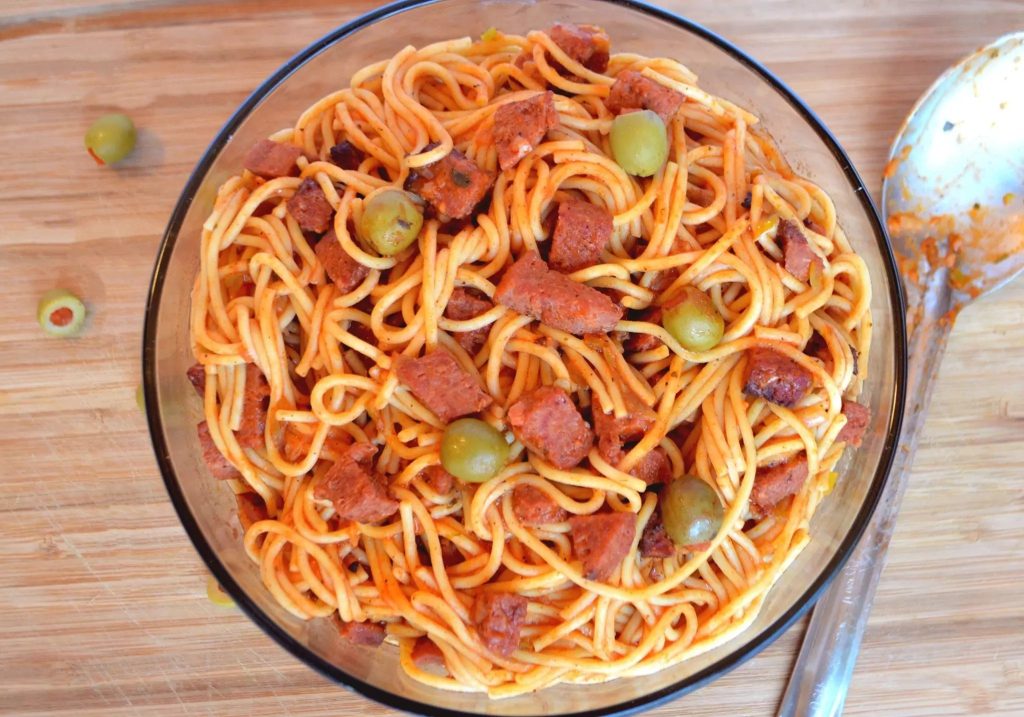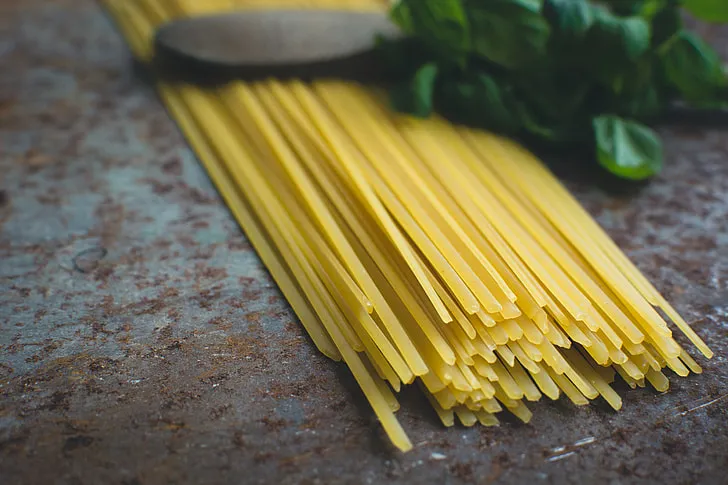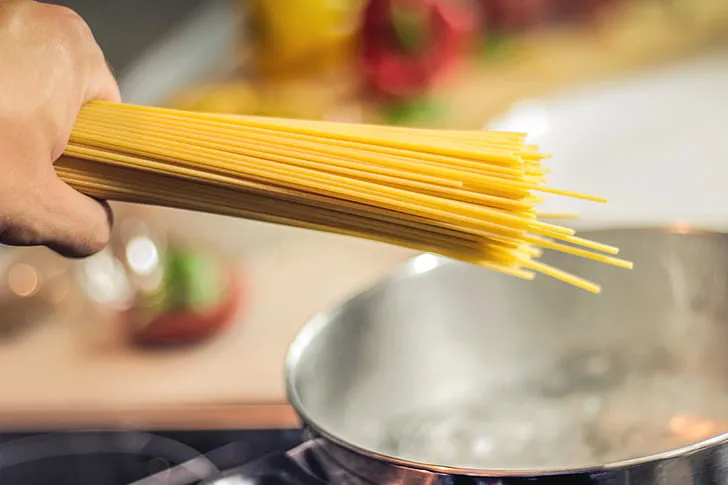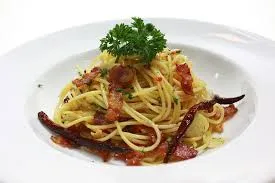The Best Fluffy Pancakes recipe you will fall in love with. Full of tips and tricks to help you make the best pancakes.
If you’re looking for a quick, flavorful, and comforting meal, look no further than Easy Dominican Spaghetti. This dish, popular in Dominican cuisine, takes the familiar concept of spaghetti and adds a vibrant Caribbean twist with bold seasonings and savory ingredients. Perfect for busy weeknights, Dominican spaghetti combines simple pantry staples like pasta, sofrito, and fresh vegetables into a delicious meal that’s both satisfying and full of flavor. Whether you’re new to Dominican food or a seasoned fan, this easy recipe will bring the taste of the Dominican Republic right to your kitchen with minimal effort. Let’s dive into how to make this quick and irresistible dish!
The Origins of Dominican Spaghetti
Dominican spaghetti, or “Espagueti a la Dominicana,” is a beloved dish in the Dominican Republic, deeply rooted in the country’s rich cultural history. While pasta itself is of Italian origin, this unique Dominican variation reflects the country’s fusion of African, Spanish, and indigenous Taino influences, resulting in a dish that’s both familiar and distinctively Caribbean.

Historical Background and Cultural Influence
The Dominican Republic, like many Caribbean nations, has a diverse history that blends various cultures, and this is mirrored in its cuisine. The introduction of pasta to the island came with the influence of European settlers, particularly the Spanish. However, over time, Dominican cooks infused the dish with ingredients and flavors from their African and Taino heritage, creating a version that is far from traditional Italian spaghetti.
The use of sofrito, a seasoning base of garlic, onions, peppers, and herbs, is a prime example of this blend. While sofrito is a key component in many Latin American dishes, it gives Dominican spaghetti its signature bold and aromatic flavor. This seasoning base adds depth and complexity to the dish, transforming a simple pasta meal into something vibrant and comforting.
Key Ingredients and the Caribbean Twist
What sets Dominican spaghetti apart from its Italian counterpart is the use of local ingredients that bring a distinct Caribbean twist to the dish. In the Dominican Republic, it’s common to add meat, such as sausage, chicken, or even ground beef, making the dish heartier and more flavorful. These meats are often seasoned with additional herbs and spices, further infusing the spaghetti with the rich, savory flavors of the Caribbean.
Tomatoes, onions, and peppers are staples in Dominican cooking, and they also form the base of the pasta sauce in this dish. When combined with the bold, fragrant sofrito, these ingredients create a sauce that clings perfectly to the spaghetti, resulting in a dish that’s both savory and satisfying.
Dominican Spaghetti Today
Today, Dominican spaghetti is a popular comfort food in Dominican households, often served as a quick and delicious meal for busy families. It’s frequently enjoyed with fried plantains or a side salad, making it a well-rounded meal that’s perfect for lunch or dinner. While the dish is rooted in tradition, it’s incredibly versatile and can be easily adapted to suit personal preferences, whether by adding extra vegetables, experimenting with different meats, or spicing it up with hot sauce.
As simple as it may seem, Dominican spaghetti reflects the heart and soul of Dominican cuisine: bold, flavorful, and a celebration of cultural influences. The next time you prepare this dish, you’re not just making a meal – you’re connecting with a rich history and tradition that spans continents and centuries.
Key Ingredients That Make Dominican Spaghetti Unique
The true magic of Dominican Spaghetti lies in the ingredients that come together to create a dish that’s both simple and full of flavor. While the base of the dish is the familiar spaghetti pasta, it’s the unique blend of seasonings, fresh vegetables, and meats that give it its distinctive Caribbean twist. Let’s take a closer look at the key ingredients that make Dominican spaghetti stand out.

1. Sofrito: The Heart of Dominican Flavor
One of the most important ingredients that sets Dominican spaghetti apart is sofrito. This savory seasoning blend is the backbone of many Dominican dishes, and it’s what gives Dominican spaghetti its rich, aromatic flavor. Sofrito is made from a combination of garlic, onions, peppers (often bell peppers or ajíes), cilantro, and sometimes tomatoes, all sautéed together to create a flavorful base for the sauce.
In the case of Dominican spaghetti, sofrito infuses the pasta sauce with deep, savory notes, adding an authentic Caribbean flavor that you won’t find in traditional Italian pasta dishes. This mixture serves as a foundation for most Dominican cooking, bringing a comforting, aromatic element to everything from stews to rice and beans.
2. Pasta: The Perfect Vehicle for Bold Flavors
While traditional Dominican spaghetti can be made with any kind of pasta, the dish is most commonly made with spaghetti noodles, which serve as the perfect canvas for the vibrant sauce and seasonings. The pasta itself is relatively simple, but its role is crucial: it absorbs all the delicious flavors from the sofrito and sauce, making each bite full of taste.
In some variations of Dominican spaghetti, you may even find other types of pasta like elbow macaroni or fusilli used in place of spaghetti, but the traditional version remains a staple in many Dominican kitchens. The key is to cook the pasta al dente (firm to the bite) to ensure it holds up well when mixed with the sauce.
3. Tomatoes: The Tangy, Sweet Base of the Sauce
Tomatoes are an essential part of the Dominican spaghetti sauce, providing a natural sweetness and acidity that balances out the savory depth of the sofrito. Whether used in the form of fresh diced tomatoes or tomato paste, the tomatoes add a velvety richness that coats the pasta perfectly.
Tomatoes also act as a natural thickener for the sauce, allowing it to cling to the noodles rather than run off. The combination of tomatoes and sofrito results in a sauce that is tangy, savory, and slightly sweet—the perfect match for the mild spaghetti.
4. Meat Additions: Elevating the Dish with Protein
What makes Dominican spaghetti truly hearty and satisfying is the addition of protein. While the dish can certainly be made vegetarian, many recipes call for sausage, chicken, or ground beef to add both richness and texture to the meal.
- Sausage: Often used in Dominican spaghetti, sausage adds a bit of spice and a savory kick. The fat in the sausage helps create a richer sauce, and the slight heat from the seasoning blends wonderfully with the other flavors in the dish.
- Chicken: A leaner option, chicken is often added to Dominican spaghetti for a milder flavor. Typically, it’s cooked in small pieces or shredded, allowing it to absorb the seasoning and blend into the dish.
- Ground beef: Another common addition, ground beef makes the dish feel more like a full meal. It’s often browned and mixed into the sauce, adding a satisfying, meaty texture that complements the soft pasta.
These meats can be easily customized based on personal preference, making Dominican spaghetti a versatile dish that can be enjoyed by everyone.
5. Olive Oil and Other Seasonings: Enhancing and Balancing the Flavors
To bring all the flavors together, a good amount of olive oil is used for sautéing the sofrito, as well as drizzling over the pasta. Olive oil adds a smooth, slightly fruity richness that enhances the natural flavors of the ingredients.
In addition to sofrito, other common seasonings in Dominican spaghetti include oregano, salt, pepper, and sometimes a bit of bay leaf or thyme. These seasonings are what elevate the dish from just a basic pasta meal to something much more flavorful and aromatic. Dominican spaghetti also often includes a dash of vinegar or a squeeze of lime juice, giving the dish a slightly tangy edge that cuts through the richness.
6. Optional Add-Ins: Customizing Your Dish
While the core ingredients remain consistent, Dominican spaghetti is easily customizable. Some cooks like to add bell peppers, olives, or capers for extra flavor and texture. For a bit of heat, you can also toss in a small amount of hot sauce or chili flakes. These add-ins are optional but provide the opportunity to experiment with the dish and create your own version that fits your flavor preferences.
How to Make Quick and Flavorful Dominican Spaghetti
Making Dominican Spaghetti is easier than you might think, and the process doesn’t take much longer than making a traditional pasta dish. The key to creating a flavorful, authentic Dominican spaghetti is in the seasoning, the savory meat additions, and the sauce preparation. Here’s a simple step-by-step guide to prepare this vibrant dish that brings a taste of the Caribbean right to your kitchen.

Step 1: Prepare the Pasta
The first step in making Dominican spaghetti is cooking the pasta. Use spaghetti noodles or any pasta of your choice (elbow macaroni and fusilli are also popular choices in some Dominican homes). Here’s how to get the perfect pasta:
- Bring a large pot of water to a boil, adding a generous pinch of salt to enhance the pasta’s flavor.
- Add the spaghetti and cook it according to the package instructions, usually for about 8-10 minutes, until the pasta is al dente (firm to the bite).
- Once the pasta is ready, drain it, reserving a small cup of the pasta water. This can be added to the sauce later to help it thicken and better adhere to the pasta.
While your pasta is cooking, you can begin preparing the sauce and meat.
Step 2: Make the Dominican Sofrito Base
The heart of Dominican spaghetti lies in the sofrito—a flavorful seasoning base that’s essential to many Dominican dishes. Here’s how to make the sofrito:
- Heat olive oil in a large skillet or pot over medium heat. You’ll need about 2 tablespoons of oil.
- Add 1 small diced onion, 2 minced garlic cloves, and 1 small bell pepper (diced) to the skillet. Sauté these ingredients for about 2-3 minutes until the onions become translucent and fragrant.
- Next, add about 1 teaspoon of chopped cilantro and 1 diced tomato (or 1-2 tablespoons of tomato paste) to the mix. Allow everything to cook together for another 3-4 minutes. You’ll know the sofrito is ready when the tomatoes soften and begin to release their juices.
This blend of garlic, onions, peppers, and tomatoes is what gives Dominican spaghetti its deep, savory flavor, so don’t rush this step—let it cook down until the flavors meld together.
Step 3: Cook the Meat (If Using)
Now, it’s time to add your protein. The most common meats used in Dominican spaghetti are chicken, sausage, or ground beef, but you can adjust the recipe based on your preference.
- For sausage: Slice the sausage into small pieces or rounds and add them to the sofrito. Let them brown for about 5-7 minutes until they’re cooked through and slightly crispy around the edges. The sausage will release its oils, adding extra flavor to the sauce.
- For chicken: If you’re using chicken, it’s often best to shred or chop it into bite-sized pieces. Season the chicken with a bit of salt, pepper, and oregano, then sauté in the same pan for 5-7 minutes, until browned and fully cooked.
- For ground beef: Brown the ground beef in the pan with the sofrito, breaking it up into small crumbles as it cooks. Allow it to cook for about 8-10 minutes until fully browned.
Once the meat is cooked, mix it well with the sofrito to allow the flavors to combine. If your meat starts to stick to the pan, feel free to add a splash of water or broth to deglaze the skillet.
Step 4: Create the Sauce and Combine
Now, it’s time to bring the sauce together:
- Add about 1 can (14 oz) of diced tomatoes or tomato sauce to the pan with the sofrito and meat. Stir everything together, allowing the tomato sauce to meld with the sofrito and the meat.
- Season the sauce with salt, pepper, oregano, and a pinch of sugar (to balance the acidity of the tomatoes). If you like a little heat, you can also add a dash of hot sauce or chili flakes.
- Let the sauce simmer for about 5-10 minutes, allowing it to thicken and the flavors to deepen.
During this time, if the sauce becomes too thick, you can add a small amount of pasta water (the water you reserved from the pasta) to adjust the consistency.
Step 5: Combine the Pasta with the Sauce
Once the sauce is ready, it’s time to combine the pasta and the sauce:
- Add the drained spaghetti to the skillet with the sauce. If you’re using a large pot, simply transfer everything into the pot where the pasta was cooked.
- Toss the pasta in the sauce to coat each strand thoroughly, making sure the pasta absorbs all the delicious flavors. If you find the sauce a bit too dry, add more pasta water a little at a time until you reach the desired consistency.
- Taste and adjust the seasoning: Add extra salt, pepper, or herbs as needed.
Step 6: Final Touches and Serve
To finish off your Dominican spaghetti:
- Garnish with some chopped fresh cilantro or sliced olives for extra flavor and color.
- Serve the pasta hot, either as-is or with a side of fried plantains (tostones) or a fresh salad to complete the meal.
Quick Tips:
- Customize your protein: You can add shrimp, pork, or even use plant-based proteins for a vegetarian version of the dish.
- Don’t skip the sofrito: It’s the key to achieving that authentic Dominican flavor.
- Make ahead: You can make the sauce ahead of time and store it in the fridge for a few days. Just toss it with freshly cooked pasta when you’re ready to serve.
Why You’ll Love Easy Dominican Spaghetti
Easy Dominican Spaghetti is more than just a meal—it’s a flavor-packed, comforting dish that captures the essence of Dominican cuisine while being incredibly simple to make. Whether you’re a fan of bold Caribbean flavors or just looking for a quick, satisfying dinner, this dish offers a unique twist on the classic spaghetti we all know and love. Here are a few reasons why you’ll fall in love with Easy Dominican Spaghetti:
1. Quick and Easy to Make
One of the best reasons to love this dish is its simplicity. In just under 30 minutes, you can have a full, flavorful meal on the table that rivals more complicated recipes. The preparation is straightforward, and the ingredients are easy to find at any grocery store, making it the perfect choice for busy weeknights.
Whether you’re an experienced cook or just starting out, Dominican spaghetti is beginner-friendly. With just a few simple steps—boiling pasta, sautéing sofrito, adding meat, and combining everything—you’re guaranteed a delicious result every time.
2. Bursting with Flavor
At the heart of Dominican spaghetti is the soothing, yet vibrant blend of sofrito, tomatoes, and local seasonings. This seasoning base infuses the dish with deep, savory flavors that turn what could be a basic pasta meal into something extraordinary. The sofrito provides layers of garlic, onions, peppers, and cilantro, which bring the dish to life, while the tomatoes add a natural sweetness and slight tang that perfectly balances the richness of the meat.
The seasonings like oregano, pepper, and bay leaves, combined with the added choice of meats, like sausage, ground beef, or chicken, transform this dish into something much more satisfying than regular spaghetti. The result is a hearty meal that explodes with rich Caribbean flavors in every bite.
3. Customizable for Every Taste
Dominican spaghetti is incredibly versatile and can be tailored to suit various dietary preferences and tastes. Whether you’re a meat lover, vegetarian, or looking for a lighter option, there are plenty of ways to make this dish your own:
- Vegetarian-friendly: If you prefer a meatless version, simply omit the protein and load up on vegetables like bell peppers, mushrooms, or zucchini. You can also add extra beans or legumes for added protein and texture.
- Protein-packed: For a hearty meal, add chicken, sausage, or ground beef. If you’re feeling adventurous, try shrimp or pork for a different flavor profile.
- Spicy twist: Love heat? Add a dash of hot sauce, chili flakes, or even some fresh diced jalapeños to give the dish a spicy kick.
- Family-friendly: Because the dish is so flexible, it’s a great option for feeding a crowd. You can easily adjust the portions to accommodate your family’s preferences, and it works well with side dishes like fried plantains (tostones) or a crisp, refreshing salad.
No matter how you customize it, Dominican spaghetti will always be a satisfying and delicious meal that can please everyone at the table.
4. A One-Pot Wonder
Another reason to love Easy Dominican Spaghetti is its simplicity in cleanup. Since most of the cooking is done in a single skillet or pot, it makes for easy cleanup after the meal. The sauce, pasta, and meat cook together in one pan, allowing the flavors to meld seamlessly without the need for multiple dishes. For busy families or individuals who want to spend less time cleaning and more time enjoying their food, this dish is a total win.
5. A Taste of the Dominican Republic in Every Bite
One of the most appealing aspects of Dominican spaghetti is that it allows you to bring the flavors of the Caribbean straight into your kitchen. The use of sofrito, the essential Dominican seasoning base, and local ingredients like cilantro, plantains, and tomatoes offers an authentic taste of the Dominican Republic. It’s a comforting and nostalgic dish that takes you to a tropical island with each bite.
Whether you’ve visited the Dominican Republic or have never set foot on the island, this dish will give you a taste of its vibrant culture and rich food traditions. Cooking and eating Dominican spaghetti feels like taking a little culinary trip to the Caribbean without leaving your home.
6. Budget-Friendly and Satisfying
If you’re looking for a meal that’s affordable without compromising on taste, look no further. Dominican spaghetti is made from basic, inexpensive ingredients like pasta, tomatoes, and sofrito, which means you don’t have to break the bank to enjoy a flavorful dish. Additionally, since you can make a large batch in one pot, it’s a perfect choice for families, meal prepping, or feeding a crowd without spending too much time or money.
This dish is also very filling, with its mix of pasta, protein, and flavorful sauce, ensuring everyone leaves the table satisfied. You won’t have to worry about people going hungry, and any leftovers can be easily stored for another meal.
7. A Comforting, Hearty Meal
There’s something about a big plate of pasta coated in a savory sauce that is inherently comforting. Dominican spaghetti offers that same warmth and familiarity, but with a twist of Caribbean flavors that make it feel special. It’s a hearty meal that provides both nourishment and satisfaction—perfect for those cozy nights when you just need a bowl of comfort food. Whether you’re sitting down to enjoy it with family or serving it at a gathering, Dominican spaghetti is the kind of dish that brings people together.
Serving Ideas and Pairing Suggestions
Easy Dominican Spaghetti is a flavorful dish that stands strong on its own, but when paired with the right sides and beverages, it can turn into a well-rounded, satisfying meal that your family and guests will rave about. Whether you’re looking for traditional sides or want to create a fusion experience, here are some serving ideas and pairing suggestions to elevate your Dominican spaghetti experience.

1. Classic Dominican Sides to Complement Spaghetti
To stay true to the roots of Dominican cuisine, pairing Dominican spaghetti with traditional sides is a fantastic choice. These sides complement the flavors of the pasta and round out the meal in a way that feels balanced and hearty.
- Tostones (Fried Green Plantains): These crispy, salty slices of plantain are a staple of Dominican meals and make an excellent side dish to Dominican spaghetti. The crispy exterior and tender interior offer a perfect textural contrast to the soft, savory pasta. Serve them alongside the spaghetti for a delightful mix of flavors and crunch.
- Mangu (Mashed Plantains): Another traditional Dominican side, mangu is made from mashed green plantains, typically served with a bit of fried cheese and salami. The creamy, savory flavor of mangu pairs wonderfully with the rich, tomato-based sauce in Dominican spaghetti. It’s a hearty addition to any meal that combines perfectly with the pasta’s savory notes.
- Ensalada Verde (Simple Green Salad): A fresh, crisp green salad with a simple vinaigrette can help balance the richness of the pasta. The acidity and crunch of the salad provide a nice contrast to the more filling spaghetti, making it a refreshing and light complement to the meal.
For more side dish ideas to pair with pasta, check out this collection of side dishes for pasta.
2. Adding More Vegetables to the Plate
If you want to incorporate more vegetables into your meal, there are several great options to pair with Dominican spaghetti:
- Avocado Slices: Known as a beloved ingredient in Dominican cuisine, avocado is a perfect way to add a creamy, mild flavor to your meal. Serve fresh avocado slices on the side, either alone or with a sprinkle of salt and lime, for a cool, refreshing complement to the warmth of the pasta.
- Roasted Vegetables: Roasting a mix of vegetables like zucchini, bell peppers, carrots, or even cauliflower can add depth and natural sweetness to your meal. Roasting brings out the vegetables’ natural flavors, making them a perfect pairing with the savory spaghetti.
- Corn on the Cob: A simple, boiled or grilled corn on the cob makes for an excellent side dish. The sweetness of the corn is a great contrast to the savory tomato-based sauce in the spaghetti, and its natural flavors enhance the overall meal.
3. Bread and Baked Goods to Serve
While pasta is already filling, a little bread on the side can elevate the experience, especially if you enjoy dipping your bread in the sauce!
- Garlic Bread: A warm, buttery garlic bread pairs wonderfully with Dominican spaghetti. Its crisp, crunchy texture and garlicky flavor complement the rich, savory sauce and add another layer of comfort to your meal.
- Dominican Pan de Agua (Water Bread): This light, airy bread is perfect for soaking up the delicious sauce from the spaghetti. It’s commonly enjoyed in Dominican meals and adds a traditional touch to your dining experience. You can also use it for sandwiches or to mop up leftover sauce.
- Cheese-Stuffed Breads: For a bit of indulgence, consider pairing your spaghetti with soft, cheese-stuffed bread, which adds richness and a delightful melt-in-your-mouth texture that complements the tangy tomato sauce of the pasta.
4. Adding Protein to the Meal
If you’re craving even more protein, you can serve Dominican spaghetti with additional meat dishes or proteins that will harmonize with the flavors in the pasta.
- Grilled Chicken: Whether you choose grilled chicken breasts or juicy chicken thighs, grilled chicken is a great addition to Dominican spaghetti. The smoky char from the grill enhances the pasta’s flavor, and the protein adds an extra layer of satisfaction.
- Fried or Grilled Fish: Dominican cuisine loves to pair pasta with fish, so serving your spaghetti alongside a portion of fried or grilled fish is a fantastic option. The lightness of the fish balances out the rich sauce, and the flavors of the sea complement the freshness of the tomato and herbs. For more quick and easy fish plate recipes, check out this collection of recipes.
- Sausage: Since sausage is often included in Dominican spaghetti, serving an extra side of grilled sausage links or chorizo can boost the protein content and add a slightly spicy, smoky flavor that complements the pasta perfectly.
5. Pairing Drinks for the Ultimate Experience
Drinks can really enhance your Dominican spaghetti meal, so whether you prefer a refreshing non-alcoholic beverage or something a little stronger, here are some great options:
- Mango or Passion Fruit Juice: The natural sweetness and slight tartness of tropical fruit juices like mango or passion fruit perfectly complement the savory richness of Dominican spaghetti. These drinks are incredibly refreshing and align with the vibrant Caribbean flavors of the meal.
- Santo Libre (Rum and Coke): For a more traditional Dominican alcoholic beverage, try pairing your meal with a Santo Libre, which is a Dominican cocktail made with rum and Coca-Cola. It’s sweet, bubbly, and perfectly balanced with the flavors of the pasta.
- Cold Beer: A light beer, like a pale lager or pilsner, is an excellent choice to pair with Dominican spaghetti. The crispness of the beer cuts through the richness of the pasta, making it a perfect complement for those who enjoy a refreshing, chilled beverage with their meal.
- Iced Tea with Lime: For a non-alcoholic option, iced tea with a splash of lime works beautifully. It’s slightly tangy and refreshing, providing a palate cleanser between bites of the rich pasta.
6. Desserts to Complete the Meal
Finish your meal with a sweet treat to cleanse your palate and wrap up the delicious Dominican experience.
- Flan: A classic Dominican dessert, flan is a smooth, creamy custard topped with a rich caramel sauce. Its sweetness and velvety texture make it an ideal dessert to enjoy after a savory meal like Dominican spaghetti.
- Dulce de Leche (Caramelized Milk): A rich, indulgent dessert that you can serve as a topping for ice cream or as a filling for pastries. The caramel flavor complements the savory pasta while providing a sweet conclusion to the meal.
- Tres Leches Cake: For those who love cakes, Dominican Tres Leches is a must-try. This light, airy sponge cake soaked in a combination of three types of milk (evaporated milk, sweetened condensed milk, and heavy cream) is perfectly moist and sweet, making it a great choice for dessert.






[…] How about eating this dish for dinner Dominican Spaghetti? If you are a fan of Spaghetti, you will love this recipe. 🍝👉👉Easy Dominican Spaghetti: A Quick and Flavorful Meal […]